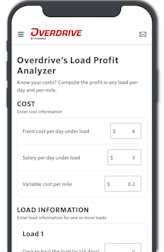Overdrive sister publication CCJ hosted prominent freight-focused academics Jason Miller, professor of supply chain management in the business school at Michigan State, and MIT Center for Transportation and Logistics Executive Director Chris Caplice for a roundtable discussion Thursday, February 13, that offered perspective on what economic data might tell us about where we're headed in 2025 for freight, rates and more.
Call it a discussion of Truckonomics, as CCJ Editor Jason Cannon quipped to start the discussion, which touched on spot and contract rates and freight-volume recovery, tariffs and uncertainty in the business community, potential business tax cuts, and more. Where we're headed for rates and volumes could depend a lot on just what the Trump administration does or doesn't do, in the view of both panelists, to bring a measure of certainty to the business community, spurring investment that otherwise won't happen.
A chief driver of uncertainty? Tariffs and/or the threat of them, said Miller, who was in consensus with Caplice about where we are in the current freight cycle after the long fall-off in freight volumes and rates from the last high in early 2022.. Supply and demand for freight movement have more or less hit "equilibrium," Miller said. "It will take a surge of demand to move things out of that equilibrium" for significant rates growth.

Miller predicted growth of plus-or-minus 10% over the course of 2025 for spot rates, basically "chugging along for truckload" freight through the year, likening this growth cycle to what truckers saw over the course of 2013-'14, a "much more gradual" growth period than for instance the surge in freight and rates seen in 2018 and especially during the post-pandemic period.
"Everybody needs to forget 2020-'21 ever happened," he said. Right now, the "only tailwind we have is interest rates cuts" that happened on the back half of 2024. "We're not going to see a fracking boom like we’ve seen before. Not like 2017-'18 or 2012-'14. ... Commodity prices are down for grains," and construction has been slowing, with housing prices "50% more expensive" than before COVID.
All of that's a lag on freight volumes, and seasonality's returned in earnest to spot/contract dynamics, noted Caplice, as spot rate gains in the latter part of 2024 have essentially been erased in recent weeks.
 The chart shows what Caplice traditionally looked at for clear signs of freight market improvements, a tightening of the spread between spot and contract rates -- this shows the spread for spot/contract dry van rates from DAT's Trendlines website, current as of the end of last week. "All the gains we saw coming in" starting in September for spot rates "backtracked at the end of January," Caplice said, but he expected the generally improving trend to "probably continue. The market is tightening up," but he predicted, similarly to Miller, a "slow transition going through the trough."
The chart shows what Caplice traditionally looked at for clear signs of freight market improvements, a tightening of the spread between spot and contract rates -- this shows the spread for spot/contract dry van rates from DAT's Trendlines website, current as of the end of last week. "All the gains we saw coming in" starting in September for spot rates "backtracked at the end of January," Caplice said, but he expected the generally improving trend to "probably continue. The market is tightening up," but he predicted, similarly to Miller, a "slow transition going through the trough."
Caplice further echoed Miller's skepticism about a big ramp-up in demand coming this year, likening his prediction of slow growth in freight/rates to a "slow boiling of the water as we go through the first half of 2025."
Measure of certainty could bring more growth
CCJ Editor and Overdrive contributor Cannon launched the discussion with the tariff question, which in some ways has dominated business news now for a couple of weeks, the latest a set of announced tariffs on imported steel and aluminum set to go into effect in March.
[Related: Trump tariffs on Canadian, Mexican, Chinese imports spark retaliation, measure of cooperation]
"There's no doubt the market has cooled since this tariff talk has heated up," said Miller. On the spot market, "all the gains we made in December and January are completely wiped out right now."
Dry van spot rates last week were at their lowest level since mid-November, Truckstop and FTR reported, and refrigerated spot rates fell to their lowest level since April.
[Related: Compare rates for potential profit with Overdrive's Load Profit Analyzer]
Flatbed rates were more stable, though both Miller and Caplice noted steel and aluminum tariffs a month away, if implemented, "would be a net decrease in freight demand," as Miller put it. Industries downstream who use steel and aluminum will "see their cost structures go up." He cited the example of 2018-'19 metals tariffs during which there was a "slight uptick in employment" in the manufacturing sector, yet the "decreases farther downstream outweighed the gains in employment."
Caplice contended he hadn't seen a tariff that works very well "in the past 50 to 100 years," viewing them generally as a way to "reward a narrow slice of the economy," domestic manufacturers in the case of steel and aluminum tariffs, "at the expense of the wider base."
New tariffs in place on imports from China Miller viewed as likely not of drastic consequence for domestic freight, yet the administration's "saber rattling" with Canada and Mexico, as Caplice put it, could hold huge import particularly if the status quo continues.
Uncertainty around whether those tariffs on products imported from the United States' biggest trading partners will or won't go into effect could "postpone investment in the U.S." by all manner of businesses, Miller said. "We need resolution. ... We can’t wait every month" to hear from the President whether those tariffs, currently postponed to early next month pending action from the neighboring countries, will or won't happen.
The result could be a measure of "demand destruction," Miller said, where economic and freight growth projections over 2025 fail to materialize.
"If you want to improve things, increase the certainty" for the business community, said Caplice.
Now is "probably for the biggest time in history I can think about," said Miller, where "federal policies from the executive branch can influence" the economy. Should the administration back down from tariff talk and get busy with Congressional Republicans on "business tax cuts and deregulation ... freight volumes will go up."
[Related: Truckers making progress: Top 5 priorities for the Trump administration]
CCJ's 2025 outlook online seminar will be available in full on-demand by registering at this link.













